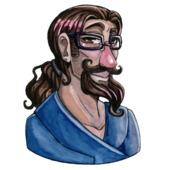Hi,
Do you have any thoughts on using grid maps where humans take up 2x2 tiles instead of 1? And do you know about any good examples of it?
The kind of games I have in mind are tactical or single character RPGs(Either turn based or real time). It would probably be overkill for games with larger armies, but it might still provide some benefits.
It gives more options for weapon range. For example: Dagger - 1, Sword - 2 Spear - 3.
Diagonal movement and attacks would be much easier to handle too.
And you can add monsters that are 1.5 times instead of twice the size of the players.
I imagine having a human body fill up 1x2 tiles, but usually standing in the middle of an area of 2x2. She could still squeeze herself through a 1 tile wide crack, or walk on a ledge(without too much armor), but it would reduce movement speed and balance. And my favourite feature coming from that: It would be possible and look natural walking past people in a less than 2 man wide hallway or walk through a crowd. ![]() It might just be a source of unnecessary complecity.
It might just be a source of unnecessary complecity.
Pros, Cons? How to implement it? Derived features?










